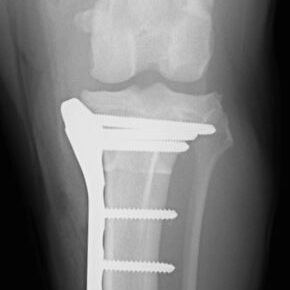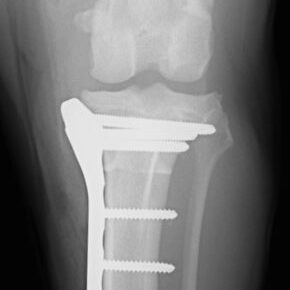Why Should I Bring my Pet to Willows for TPLO Surgery?
Willows is one of Europe’s leading small animal Orthopaedic referral centres treating over 1000 new patients a year. Our state-of-the-art hospital is led by internationally renowned Certified Specialists committed to providing the highest standards of care. Our team of Orthopaedic Specialists have performed thousands of surgeries on dogs with cranial cruciate ligament ruptures.
Our Orthopaedic Surgeons are supported by our multi-disciplinary team of Specialists across a number of disciplines including; Anaesthesia, Diagnostic Imaging and Emergency and Critical Care. Willows has a large dedicated team of Nurses and clinical support staff available 24 hours a day, every day of the year to provide the best possible care for your pet.
What is TPLO Surgery?
TPLO is the abbreviation for Tibial Plateau Levelling Osteotomy. This is a surgical procedure used to treat cranial (or anterior) cruciate ligament rupture in the knee joints (stifle) of dogs. It involves changing the angle of the top of the shin bone (the tibial plateau) by cutting the bone, rotating it, and stabilising it in a new position with a plate and screws.
Cranial cruciate ligament rupture is the most common cause of hind leg lameness in dogs. As a result TPLO surgery is one of the most common orthopaedic surgical procedures performed on dogs at Willows.
How does TPLO Surgery Work?
Following rupture of the cranial cruciate ligament, the knee becomes unstable. When the dog takes weight on the limb this instability allows the shin bone (tibia) to move forward relative to the thigh bone (femur). The knee feels as though it is ‘giving-way’ and this can cause the dog to appear severely lame.
The reason the tibia moves forward when weight-bearing is that the top of the shin bone does not sit at 90 degrees to the length of the bone. This is in contrast to people where the shin bone is parallel to the ground when standing upright with our legs straight.
TPLO surgery aims to make the shin bone vertical to the long axis of the bone and, in doing so, prevent the shin bone moving forwards. The knee thus feels stable for the dog when weight-bearing, despite the fact that the ligament has been ruptured.

What are the Most common Signs that my Pet Needs TPLO Surgery?
Tibial Plateau Levelling Osteotomy surgery is a major procedure with possible complications. As a result, it is only performed in dogs where the benefits of surgery outweigh the possible risks and where alternative methods of treatment are less successful.
Dogs that are suitable for TPLO surgery are those with a ruptured cranial cruciate ligament that have persistent lameness and knee joint instability.
Fig 1: X-rays showing plate and screws following TPLO surgery with rotation of the tibial plateau (arrow)


What does TPLO Surgery Involve?
Very specific X-rays need to be obtained of the knee and shin bone. The presence and severity of osteoarthritis can be assessed and the angle of the top of the shin bone measured to allow planning prior to surgery. The position of the cut on the bone, the amount the bone needs to be rotated, and the size of plate necessary to stabilise the bone in its new position can be evaluated.
Surgery may be performed on the same as the investigations. Antibiotics and painkillers are administered at the time of anaesthesia and the hind leg is clipped from the level of the hip to the hock (ankle). Prior to performing the TPLO, a small incision or cut is made into the knee joint to enable inspection of the structures within it. Many dogs with ruptured cranial cruciate ligaments tear one of the cartilage pads in the joint (menisci) and damaged portions need to be removed. After cutting and rotating the top of the tibia, the bone is stabilised with a special plate that has been designed especially for tibial plateau levelling surgery. Some of the screws are “locked” into the plate which makes the repair stronger.
X-rays are obtained at the end of the operation to assess the new angle of the top of the shin bone and check the position of the plate and screws. Most dogs can go home the day after surgery.
What can I Expect if my Pet Undergoes TPLO Surgery?
Aftercare following TPLO surgery is very important, and rehabilitation can take several months. Courses of painkillers and antibiotics are prescribed at discharge. If the dog tends to excessively lick the wound it may be necessary to use a plastic collar. Visits to a local Vet are necessary within the first two weeks to check the wound and remove any sutures.
Exercise must be very restricted for the first few weeks to allow healing, and is primarily for toileting purposes. The dog must be kept on a lead or harness to prevent strenuous activities such as running, jumping or playing. At other times confinement to a pen or a small room is necessary with avoidance of jumping and climbing. After a few weeks, exercise may be gradually increased in a controlled manner (on a lead). Hydrotherapy may also be recommended.
A check-up will be carried out at Willows six to eight weeks after the operation, to monitor the function of the leg and knee. X-rays are obtained to evaluate healing of the bone cut (osteotomy). Depending on progress, advice will be given about increasing exercise. Further clinical and radiographic examination may be necessary on an individual case basis.
Risks and Complications
TPLO surgery is a major procedure. There are potential complications including infection, screw loosening and slow healing of the cut bone. A small percentage of dogs that didn’t have an injured cartilage at the time of TPLO surgery tear it at a later date. A sudden increase in lameness usually develops and a second operation (keyhole or arthroscopic) is necessary to remove the torn piece of cartilage. However, in the vast majority of patients that undergo TPLO surgery, knee pain is reduced and function of the limb is improved.
To save this page as a PDF, click the button and make sure “Save as PDF” is selected.
Orthopaedics
Find out more
To assist owners in understanding more about Orthopaedics we have put together a range of information sheets to talk you through the some of the more common orthopaedic conditions seen and treated by our Specialists.

